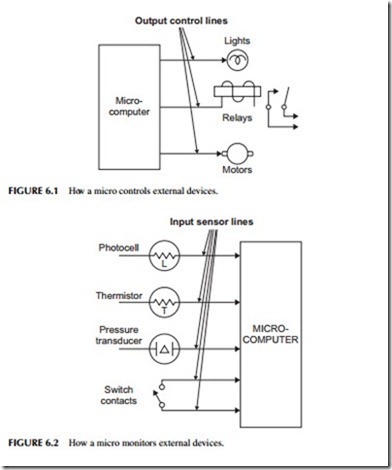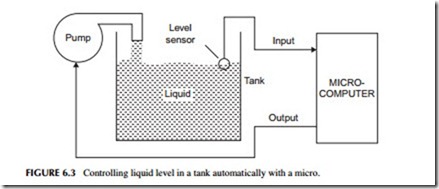CONCEPTS AND DEFINITIONS
A microcomputer is a small digital computer that can take several different forms. It can be a single integrated circuit, or it can be a module made up of several integrated circuits on a printed-circuit board.
The two most common types of microcomputers are the embedded micro- controller and the personal computer. One special type of microcomputer is the programmable logic controller (PLC) used for industrial control (Chapter 12).
The larger microcomputers, such as personal computers, are made with a microprocessor. A microprocessor is a large-scale integrated circuit that con- tains most of the digital logic circuitry usually associated with a digital com- puter. This logic circuitry is referred to as the central processing unit (CPU). A microprocessor is a single-chip CPU.
Another common micro is called a core. A core is a microprocessor or microcomputer integrated with some other circuits. The core is made on the same silicon chip as a cell phone or a security device. Today multicore micros are common. Two or more cores are used to get more processing power.
Embedded microcontrollers are complete micros on a single chip, including the CPU, memory, and input/output circuits. But in all cases, a microcomputer is an assembly of digital logic circuits, such as gates and flip-flops, that is used to process data. It is sometimes referred to as a data processor, or simply processor.
Data, of course, refers to the binary numbers and words the processor works with. Processing refers to the way the data is manipulated or handled. Types of processing include arithmetic, logic, sorting, translating, editing, counting, and searching. Any action taken on the data is called processing. Processing normally implies that the data is changed in some way or is used to create new data. Data that is not processed as suggested above is dealt with in other ways. Four common ways are storing, retrieving, input, or output. The data is not changed by any of these techniques.
Storing data means putting it in a safe place, like a semiconductor memory or disk drive, where it can be accessed later. Retrieving, of course, is the opposite of storing, or going to get the data for reuse.
Input means taking data into the computer to be stored or processed. Output means sending the data from the computer to some external device. Input and output (I/O) are ways to transmit data from one place to another.
Another feature of a microcomputer is its decision-making capability. During processing, the computer can make decisions and alter its sequence of operation. In other words, the computer can “make up its mind” based on the state of the data or outside conditions.
For example, the computer can tell if a number is less than, greater than, or equal to another. It can choose among alternative courses of actions or say yes or no, true or false, if given enough input facts.
Another major application of computers is control. Computers can be used to actuate relays and solenoids or turn lights and motors off and on (see Figure 6.1). In control applications, the computer actually determines when external devices are turned on or off. The computer serves as an electronic clock to time various operations. One example is the embedded single-chip microcontroller inside a microwave oven or a washing machine. Another example is a programmable logic controller (PLC), a special type of microcomputer used
in industrial applications, that is commonly used to sense, sequence, and time operations in a factory.
The most important thing to remember is that the control is automatic. The micro knows when to perform the various operations that it has been assigned because it has been programmed to do so.
In order to implement certain control applications, the micro must also per- form a monitoring function. The micro “looks at” the process or devices being controlled to see what is happening. For example, the computer can monitor switch closures to determine physical state or position, pressure, and many other parameters. Transducers (sensors) convert the monitored physical characteristics, such as temperature or light level, into electrical signals that the computer can understand and respond to (see Figure 6.2 ). In most microcontrollers or PLCs, the controlled output change takes place only if a specific
input condition is sensed or not sensed. For example, if a temperature sensor indicates that the temperature has risen to a specific level, the computer will turn on a cooling fan.
Micros sometimes change the control function in response to one or more of the inputs they are monitoring. For example, if the micro senses that the liquid in a tank exceeds a given level, it can automatically turn off the pump that is filling the tank. If the liquid level goes below a predetermined level, the micro detects this and automatically starts the pump (see Figure 6.3). The key point here is that the computer makes its own decisions based on the input data that it receives. The result is full automation of some process or device.
The micro’s ability to monitor and control operation may be used to auto- mate simple processes in a toy or to operate entire factories.
Related posts:
Incoming search terms:
- working of microcomputer
- microcomputer how it works
- working of micro computer
- what is principles of micro computer
- how micro computer work
- functions of micro computer
- what makes up a micro computer
- how microcomputer works
- working principles of micro computer
- explain how the micro computer works
- how does a microcomputer function
- how microcomputer
- microcomputer
- how do microcomputers work
- what microcomputers do
- discuss the working principles of a microcomputer
- how does a microcomputer work
- working principles of a microcomputer
- Micro computer working
- discuss micro computer
- how to work microcomputer
- micro computer used for personal work
- how does micro computer work
- how does microcomputer work
- main functions of micro computer
- www micro computer of work
- how does micro computer works
- how does microcomputers function
- how to work working of microcomputer
- how microcom
- How to work with micro computer
- discus how micro computers work?
- how microcomputer work
- explain working of microcomputer
- describe working principles of a microcomputer
- Detail of micro-computer and how it use
- discuss how microcomputer works
- discuss on micro computer
- Discuss the concept of micro computer
- discuss the working princeples of a microcomputer
- discuss the working principle of a microcomputer
- Function of Micro comoutee
- function of micro computer
- function of microcomputer
- functions of micro computers
- Functions Of Microcomputer Manufacturers mail
- how a microcomputer functions
- How does a micocomputer process data
- how does a micro computer process data
- how does a micro computer work

